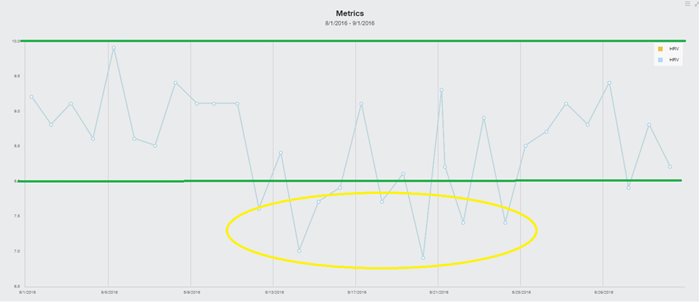TrainingPeaks allows you to link your account with a number of heart rate variability apps. This functionality provides you with a new dimension to the load metrics already provided by giving you a real-time window into how your body is handling the training load.
What Is Heart Rate Variability?
Heart rate variability (HRV) refers to the difference in time interval between heartbeats. While we might assume that if our resting heart rate is 60 beats per minute, our heart is beating rhythmically every second. The reality is that, in a healthy athlete, there is actually quite a bit of variability in the time between beats. There might be a 0.8s gap between some beats and a 1.2s gap between others. This variability is actually a hallmark of a healthy and responsive autonomic nervous system.
But when variability is diminished for a period of time, it is a good sign that you may be on the verge of overtraining, getting sick, or at the very least, tired enough that your ability to respond to training is compromised. By keeping a vigilant eye on your heart rate variability, you can get useful and practical information about your risk of overtraining and your readiness to accept the load.
Using HRV in TrainingPeaks to Avoid Overtraining
Unsurprisingly, several studies have shown that there is diminished, and in some cases, a negative effect to loading the body when it is already tired. From a planning point of view, it makes the most sense to do the hardest work when your body is relatively fresh and to do the easier recovery work when your body is already tired. While this concept makes common sense, tiredness isn’t always easy to assess. Motivated athletes tend to deny tiredness (to both themselves and their coach). In fairness to them, tiredness can often manifest more as an uneasy agitation rather than a desire to sleep. By looking at HRV daily, we can get better visibility into true, whole-system fatigue.
Below is an example of this visibility using TrainingPeaks’ HRV metrics chart for a professional triathlete that I work with.

This athlete’s long-term average HRV score (from all data to date) is 9.0, with a standard deviation in daily values of 1.0. In other words, the vast majority of this athlete’s values fall within the range of 8.0-10.0, shown by the green solid lines on the chart.
Whenever a value falls outside these limits, it is in the “something is a little off from normal” category and raises a yellow flag. When a string of values falls below this line within a relatively short period of time (as shown above), it raises a big red flag.
This sort of window into the tiredness of the nervous system is an incredible asset. Often, this form of tiredness manifests in the “tired but wired” mode where the athlete might be a bit more grumpy and irritated than usual, but the need for rest is not apparent and, in fact, may be actively fought against.
Additionally, this sort of fatigue isn’t always indicated in the acute training load number on the Performance Management Chart (PMC). It is often related to non-training stressors that this chart does not reflect.

For example, take a look at the PMC chart above within the same period. The yellow circle highlights the same portion as the HRV chart. You can see that for a good portion of the time period HRV was low, Fatigue (the pink line) was also quite low, and Form (the yellow line) was actually quite high (+25-30). This suggests that the athlete should be fresh at this point. Obviously, from the HRV data, we know that wasn’t the case. In fact, we used this information to determine that more than the standard one week of recovery was needed, so we kept the load light until the HRV returned to normal and stabilized. This sort of additional insight beyond the load metrics is where HRV shines.
In my experience, it isn’t the one-off, really hard “knock-out” workout that leads to overtraining or injury. Rather, it’s the “jab, jab, jab” of an athlete who is already tired and on the ropes that sends them to the canvas. By keeping a vigilant eye on HRV, we give the athletes sufficient time and space to get off the ropes so they can safely take more work.
How You Can Monitor Your HRV in Training
- Start tracking. Choose an app that syncs to TrainingPeaks and accumulates data for a month or so of normal training/life to get a sense of the norm.
- Identify your normal range. I would recommend one standard deviation from the mean as a good starting point.
- Keep an eye on your progress relative to your normal via the TrainingPeaks HRV metrics chart (which can be added to your dashboard) to identify those one-off yellow flag days when you might want to take it a bit easier and also the red flag periods when HRV is below the norm for an extended period of time and a recovery period is needed.
As a coach, I have found incredible benefits to the additional visibility into an athlete’s readiness to accept load that HRV provides. In a sport where consistency is the name of the game, any metric that helps ward off injury, illness and overtraining offers a decisive and competitive advantage.
References
Shaffer F., & Ginsberg, J. (2017, September 28). An Overview of Heart Rate Variability Metrics and Norms. Retrieved from https://www.ncbi.nlm.nih.gov/pmc/articles/PMC5624990/










